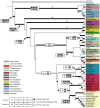A reconsideration of the classification of the spider infraorder Mygalomorphae (Arachnida: Araneae) based on three nuclear genes and morphology
- PMID: 22723885
- PMCID: PMC3378619
- DOI: 10.1371/journal.pone.0038753
A reconsideration of the classification of the spider infraorder Mygalomorphae (Arachnida: Araneae) based on three nuclear genes and morphology
Abstract
Background: The infraorder Mygalomorphae (i.e., trapdoor spiders, tarantulas, funnel web spiders, etc.) is one of three main lineages of spiders. Comprising 15 families, 325 genera, and over 2,600 species, the group is a diverse assemblage that has retained a number of features considered primitive for spiders. Despite an evolutionary history dating back to the lower Triassic, the group has received comparatively little attention with respect to its phylogeny and higher classification. The few phylogenies published all share the common thread that a stable classification scheme for the group remains unresolved.
Methods and findings: We report here a reevaluation of mygalomorph phylogeny using the rRNA genes 18S and 28S, the nuclear protein-coding gene EF-1γ, and a morphological character matrix. Taxon sampling includes members of all 15 families representing 58 genera. The following results are supported in our phylogenetic analyses of the data: (1) the Atypoidea (i.e., antrodiaetids, atypids, and mecicobothriids) is a monophyletic group sister to all other mygalomorphs; and (2) the families Mecicobothriidae, Hexathelidae, Cyrtaucheniidae, Nemesiidae, Ctenizidae, and Dipluridae are not monophyletic. The Microstigmatidae is likely to be subsumed into Nemesiidae. Nearly half of all mygalomorph families require reevaluation of generic composition and placement. The polyphyletic family Cyrtaucheniidae is most problematic, representing no fewer than four unrelated lineages.
Conclusions: Based on these analyses we propose the following nomenclatural changes: (1) the establishment of the family Euctenizidae (NEW RANK); (2) establishment of the subfamily Apomastinae within the Euctenizidae; and (3) the transfer of the cyrtaucheniid genus Kiama to Nemesiidae. Additional changes include relimitation of Domiothelina and Theraphosoidea, and the establishment of the Euctenizoidina clade (Idiopidae + Euctenizidae). In addition to these changes, we propose a "road map" for future sampling across the infraorder with the aim of solving many remaining questions that hinder mygalomorph systematics.
Conflict of interest statement
Figures


References
-
- Platnick NI. Accessed. 13 September. 2011. The World Spider Catalog, 12th ed. Available: http://research.amnh.org/iz/spiders/catalog/INTRO1.html.
-
- Coyle FA. Shear WA, editor. The role of silk in prey capture by nonaraneomorph spiders. 1986. editor. Spiders: Webs, Behavior and Evolution. Stanford, CA: Stanford University Press. pp 269–305.
-
- Coddington JA, Giribet G, Harvey MS, Prendini L, Walter DE. Cracraft J, Donoghue MJ, editors. Arachnida. 2004. Assembling the Tree of Life. Oxford: Oxford University Press. pp 269–318.
-
- Coddington JA, Levi HW. Systematics and Evolution of Spiders (Araneae). Annu Rev Ecol Syst. 1991;22:565–592.
-
- Hedin M, Bond JE. Molecular phylogenetics of the spider infraorder Mygalomorphae using nuclear rRNA genes (18S and 28S): conflict and agreement with the current system of classification. Mol Phylogenet Evol 41: 454–471. doi:10.1016/j.ympev.2006.05.017. 2006. - PubMed
Publication types
MeSH terms
Substances
LinkOut - more resources
Full Text Sources
Other Literature Sources
Molecular Biology Databases

